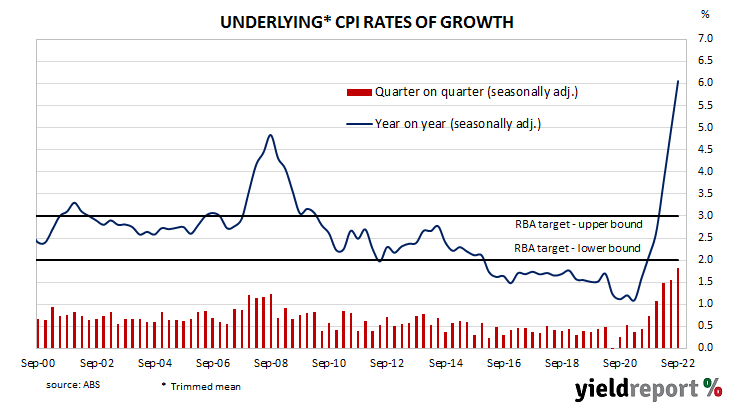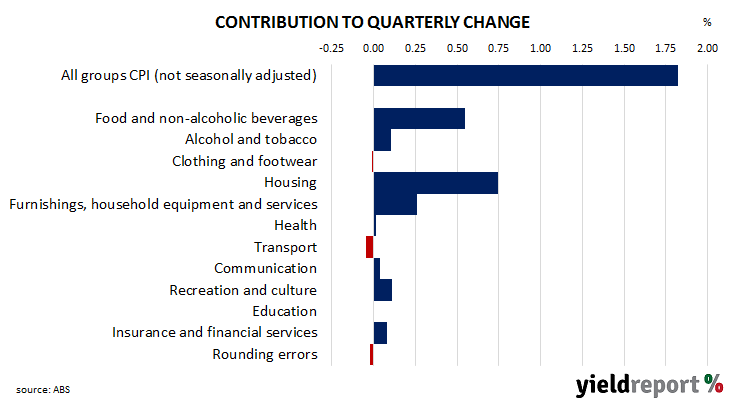Summary: Annual Inflation rate accelerates to 7.3% in September quarter, above expectations; RBA preferred measure rises from 4.9% to 6.1%; housing, food costs again main drivers of result.
In the early 1990s, high rates of inflation in Australia were reined in by the “recession we had to have” as it became known. Since then, underlying consumer price inflation has averaged around 2.5%, in line with the midpoint of the RBA’s target range. However, the various measures of consumer inflation trended lower during the decade after the GFC and hit a multi-decade low in 2020 before rising significantly in the quarters following September 2021.
Consumer price indices for the September quarter have now been released by the ABS and the seasonally-adjusted inflation rate posted a 1.8% rise. The increase was above consensus expectations of a 1.6% rise but in line with the June quarter’s result. On a 12-month basis, the seasonally-adjusted rate accelerated from 6.2% to 7.3%.
The RBA’s preferred measure of underlying inflation, the “trimmed mean”, increased by 1.8% over the quarter, above the 1.5% increase which had been generally expected as well as the June quarter’s 1.6% rise. The 12-month inflation rate rose from 4.9% to 6.1%.
Commonwealth Government bond yields dropped significantly on the day. By the close of business, the 3-year ACGB yield had lost 9bps to 3.54%, the 10-year yield had shed 16bps to 3.94% while the 20-year finished 18bps lower at 4.25%.
In the cash futures market, expectations regarding future rate rises firmed slightly. At the end of the day, contracts implied the cash rate would rise from the current rate of 2.56% to average 2.84% in November and then increase to an average of 3.06% in December. May 2023 contracts implied a 3.925% average cash rate while August 2023 contracts implied 4.155%.
The main driver of the headline inflation figure in the quarter again was a 3.2% rise in housing costs, contributing 0.75 percentage points of the 1.82% (unadjusted) increase. Food and beverage prices also had a significant influence on the quarter, rising by 3.2% and contributing 0.55% percentage points to the quarterly total.
Here’s what a few economists thought about the figures:
George Tharenou, UBS
Australian CPI remains below the peak in most major economies of 10% but the gap will narrow further in our view. Indeed, global inflation pressure is evident by tradables lifting 8.7% but the recent acceleration in domestic pressure is even sharper, with non-tradables spiking 2.0% quarter-on-quarter and 6.5% year-on-year.
Similarly, goods accelerated but services are also picking up significantly as wages increase. This suggests a bit more momentum in underlying domestic inflation pressure than previously expected, more consistent with businesses passing on cost pressures, evident by survey measures of selling prices.
Chris Read, Morgan Stanley Australia
We continue to see annual headline inflation peaking in Q4, although the stronger print implies some upside risk to our 7.8% forecast. Core inflation looks to be stabilising sequentially, although a further step up in annual growth is likely next quarter. We also expect headline inflation to reaccelerate, given removal of the fuel tax subsidy and significant electricity price increases which were mostly offset by rebates this quarter. From next year base effects become more challenging and we expect the slowing impact from rate hikes to take hold.
Catherine Birch, ANZ
Underlying and non-tradables inflation gained momentum in Q3. These broad-based, domestically driven inflationary pressures are persistent and harder for the RBA to rein in, particularly given that the overall economy is in good health with solid household spending, strong business conditions and a substantial volume of unfilled labour demand.
We see higher inflation extending into 2023 due to both the stronger Q3 data and the upside risks ahead given continuing cost pass-through, flooding, lower AUD and evidence of persistence in inflationary pressures globally.



